外研版(2019)必修第三册Unit6 Disaster and hope-Lesson2 Using language Ellipsis课件(共16张PPT)
文档属性
| 名称 | 外研版(2019)必修第三册Unit6 Disaster and hope-Lesson2 Using language Ellipsis课件(共16张PPT) | 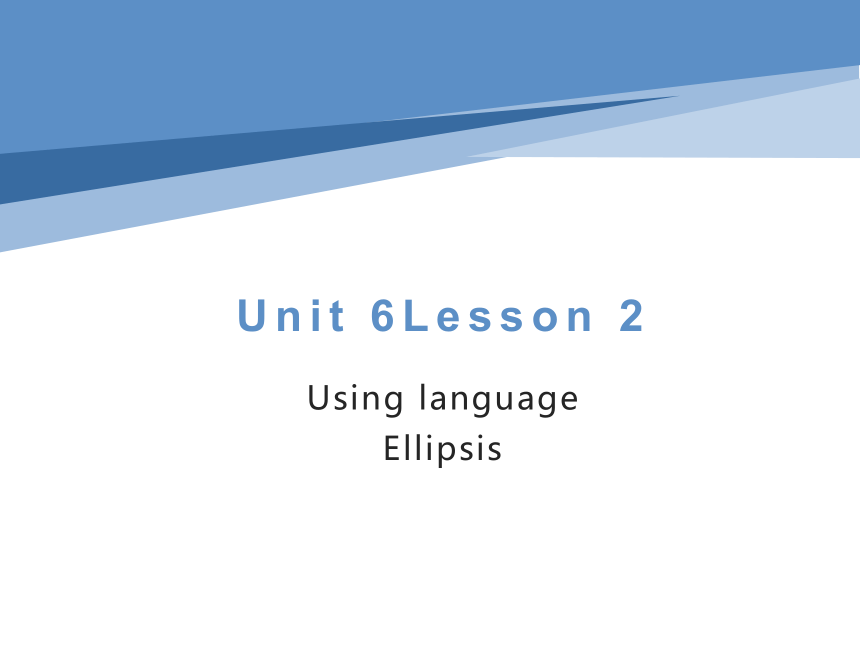 | |
| 格式 | zip | ||
| 文件大小 | 1.7MB | ||
| 资源类型 | 教案 | ||
| 版本资源 | 外研版(2019) | ||
| 科目 | 英语 | ||
| 更新时间 | 2022-06-23 08:34:55 | ||
图片预览

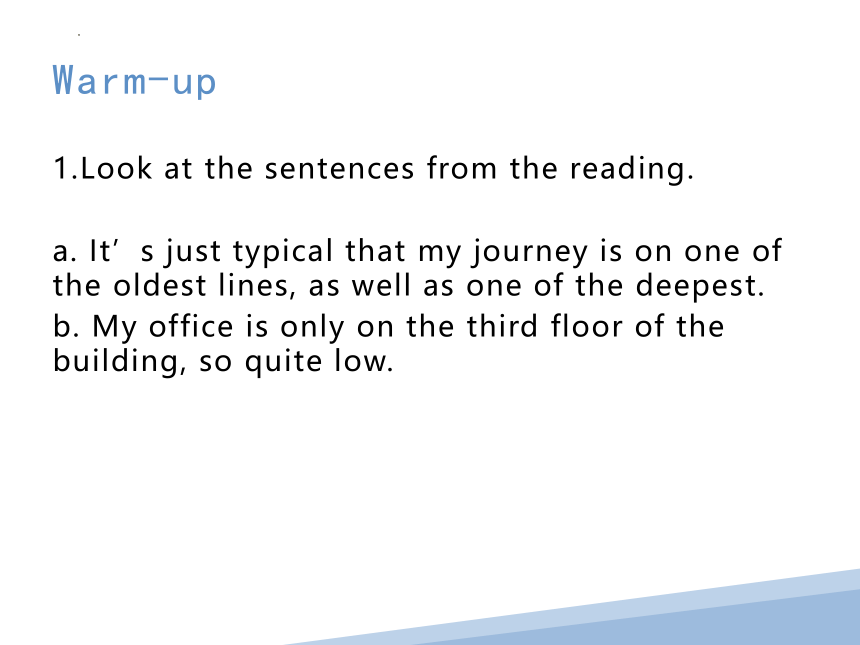
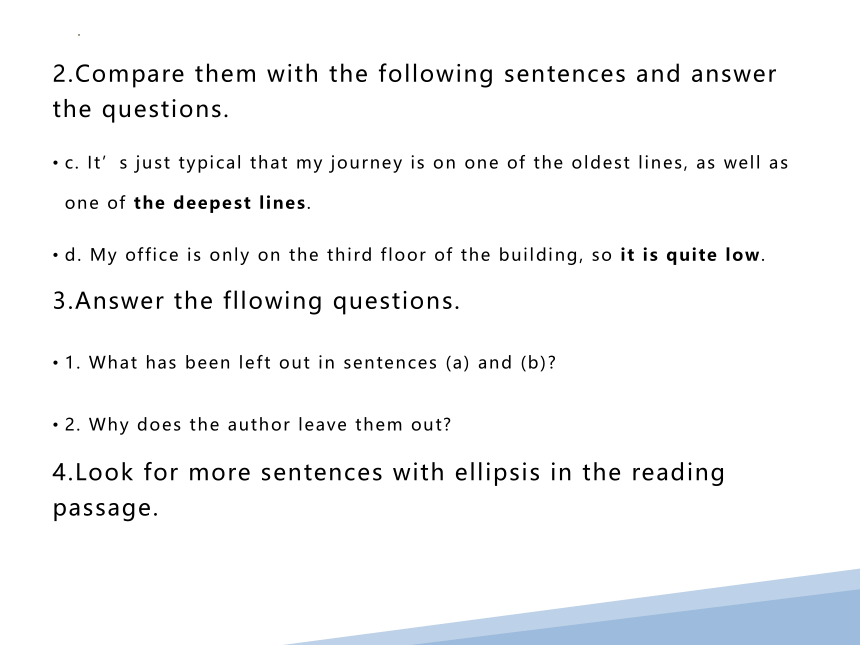
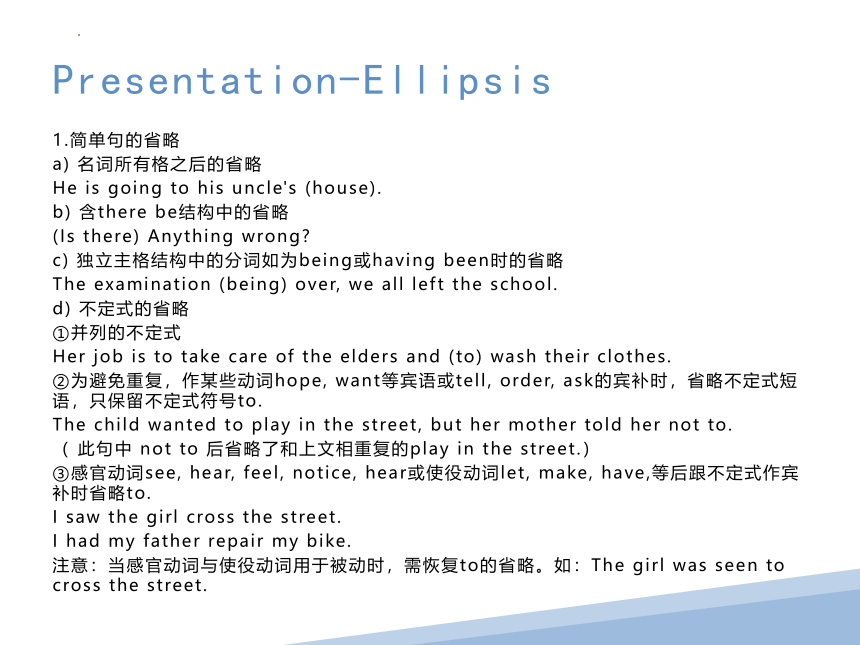
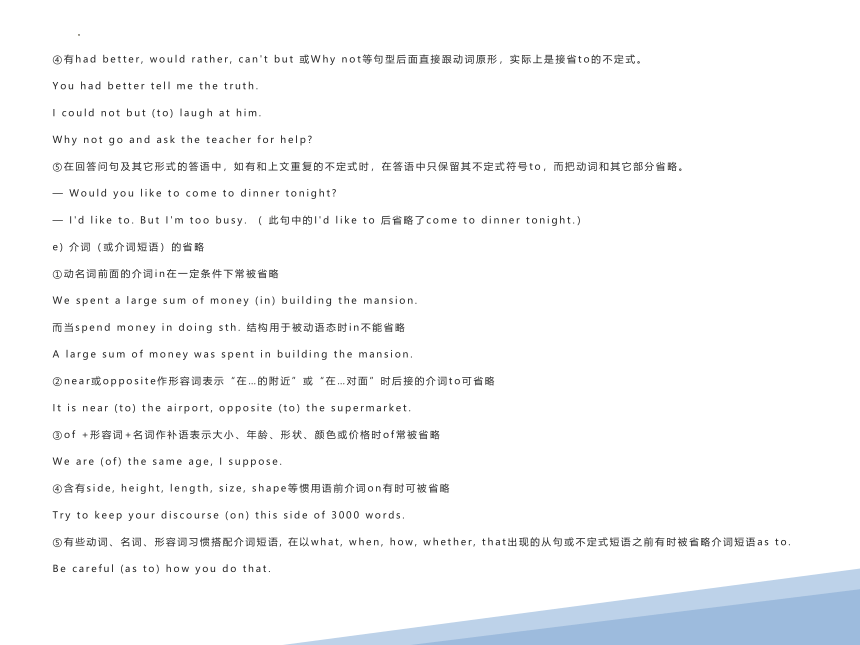
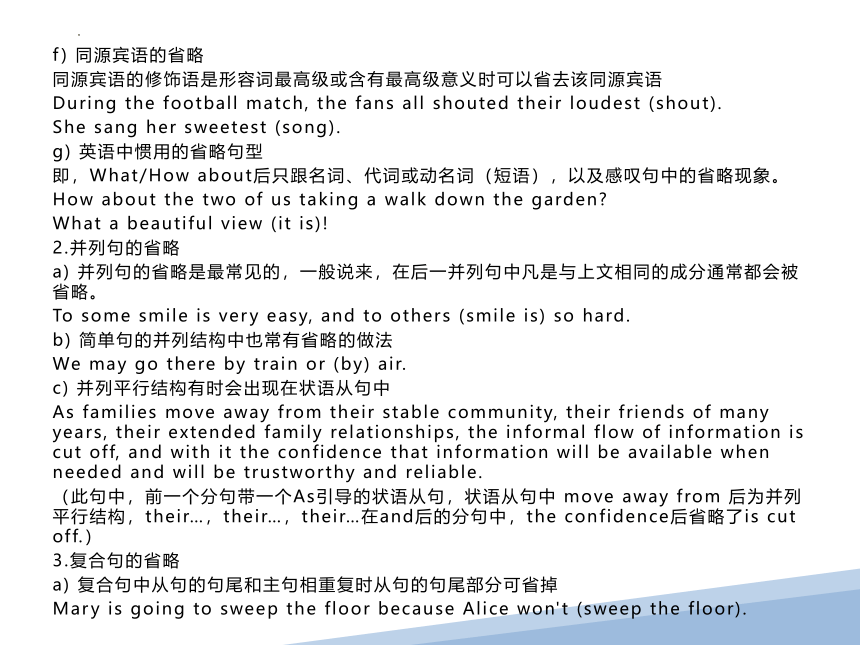
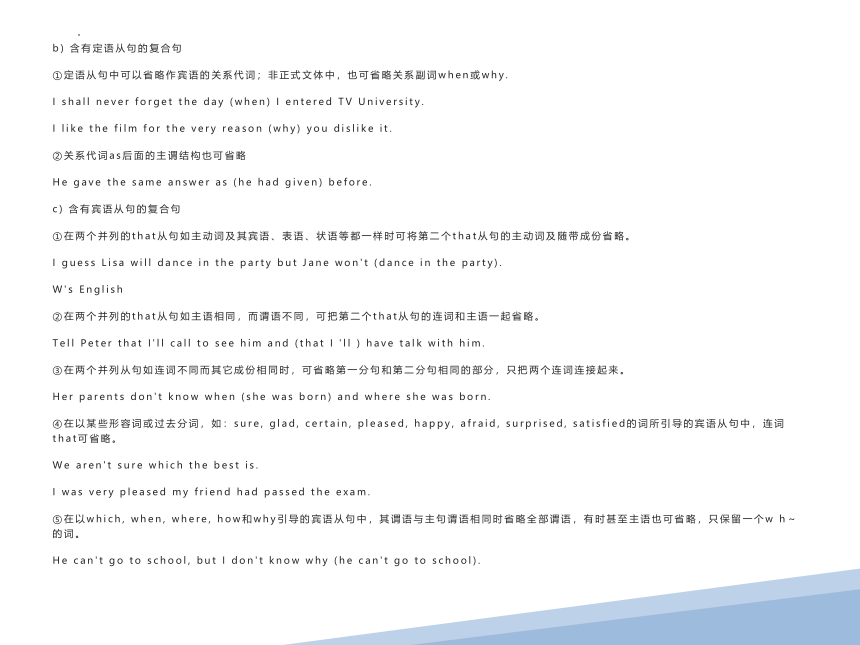
文档简介
(共16张PPT)
Unit 6Lesson 2
Using language
Ellipsis
Warm-up
1.Look at the sentences from the reading.
a. It’s just typical that my journey is on one of the oldest lines, as well as one of the deepest.
b. My office is only on the third floor of the building, so quite low.
2.Compare them with the following sentences and answer the questions.
c. It’s just typical that my journey is on one of the oldest lines, as well as one of the deepest lines.
d. My office is only on the third floor of the building, so it is quite low.
3.Answer the fllowing questions.
1. What has been left out in sentences (a) and (b)
2. Why does the author leave them out
4.Look for more sentences with ellipsis in the reading passage.
Presentation-Ellipsis
1.简单句的省略
a) 名词所有格之后的省略
He is going to his uncle's (house).
b) 含there be结构中的省略
(Is there) Anything wrong
c) 独立主格结构中的分词如为being或having been时的省略
The examination (being) over, we all left the school.
d) 不定式的省略
①并列的不定式
Her job is to take care of the elders and (to) wash their clothes.
②为避免重复,作某些动词hope, want等宾语或tell, order, ask的宾补时,省略不定式短语,只保留不定式符号to.
The child wanted to play in the street, but her mother told her not to.
( 此句中 not to 后省略了和上文相重复的play in the street.)
③感官动词see, hear, feel, notice, hear或使役动词let, make, have,等后跟不定式作宾补时省略to.
I saw the girl cross the street.
I had my father repair my bike.
注意:当感官动词与使役动词用于被动时,需恢复to的省略。如:The girl was seen to cross the street.
④有had better, would rather, can't but 或Why not等句型后面直接跟动词原形,实际上是接省to的不定式。
You had better tell me the truth.
I could not but (to) laugh at him.
Why not go and ask the teacher for help
⑤在回答问句及其它形式的答语中,如有和上文重复的不定式时,在答语中只保留其不定式符号to,而把动词和其它部分省略。
— Would you like to come to dinner tonight
— I'd like to. But I'm too busy. ( 此句中的I'd like to 后省略了come to dinner tonight.)
e) 介词(或介词短语)的省略
①动名词前面的介词in在一定条件下常被省略
We spent a large sum of money (in) building the mansion.
而当spend money in doing sth. 结构用于被动语态时in不能省略
A large sum of money was spent in building the mansion.
②near或opposite作形容词表示“在…的附近”或“在…对面”时后接的介词to可省略
It is near (to) the airport, opposite (to) the supermarket.
③of +形容词+名词作补语表示大小、年龄、形状、颜色或价格时of常被省略
We are (of) the same age, I suppose.
④含有side, height, length, size, shape等惯用语前介词on有时可被省略
Try to keep your discourse (on) this side of 3000 words.
⑤有些动词、名词、形容词习惯搭配介词短语, 在以what, when, how, whether, that出现的从句或不定式短语之前有时被省略介词短语as to.
Be careful (as to) how you do that.
f) 同源宾语的省略
同源宾语的修饰语是形容词最高级或含有最高级意义时可以省去该同源宾语
During the football match, the fans all shouted their loudest (shout).
She sang her sweetest (song).
g) 英语中惯用的省略句型
即,What/How about后只跟名词、代词或动名词(短语),以及感叹句中的省略现象。
How about the two of us taking a walk down the garden
What a beautiful view (it is)!
2.并列句的省略
a) 并列句的省略是最常见的,一般说来,在后一并列句中凡是与上文相同的成分通常都会被省略。
To some smile is very easy, and to others (smile is) so hard.
b) 简单句的并列结构中也常有省略的做法
We may go there by train or (by) air.
c) 并列平行结构有时会出现在状语从句中
As families move away from their stable community, their friends of many years, their extended family relationships, the informal flow of information is cut off, and with it the confidence that information will be available when needed and will be trustworthy and reliable.
(此句中,前一个分句带一个As引导的状语从句,状语从句中 move away from 后为并列平行结构,their…,their…,their…在and后的分句中,the confidence后省略了is cut off.)
3.复合句的省略
a) 复合句中从句的句尾和主句相重复时从句的句尾部分可省掉
Mary is going to sweep the floor because Alice won't (sweep the floor).
b) 含有定语从句的复合句
①定语从句中可以省略作宾语的关系代词;非正式文体中,也可省略关系副词when或why.
I shall never forget the day (when) I entered TV University.
I like the film for the very reason (why) you dislike it.
②关系代词as后面的主谓结构也可省略
He gave the same answer as (he had given) before.
c) 含有宾语从句的复合句
①在两个并列的that从句如主动词及其宾语、表语、状语等都一样时可将第二个that从句的主动词及随带成份省略。
I guess Lisa will dance in the party but Jane won't (dance in the party).
W's English
②在两个并列的that从句如主语相同,而谓语不同,可把第二个that从句的连词和主语一起省略。
Tell Peter that I'll call to see him and (that I 'll ) have talk with him.
③在两个并列从句如连词不同而其它成份相同时,可省略第一分句和第二分句相同的部分,只把两个连词连接起来。
Her parents don't know when (she was born) and where she was born.
④在以某些形容词或过去分词,如:sure, glad, certain, pleased, happy, afraid, surprised, satisfied的词所引导的宾语从句中,连词that可省略。
We aren't sure which the best is.
I was very pleased my friend had passed the exam.
⑤在以which, when, where, how和why引导的宾语从句中,其谓语与主句谓语相同时省略全部谓语,有时甚至主语也可省略,只保留一个w h~的词。
He can't go to school, but I don't know why (he can't go to school).
d) 含有状语从句的复合句
状语从句中的省略原则是,如主语与主句主语一致,或主语是it,可省略从句的连接词、主语和be助动词,只保留分词和其它成分,从而使语言更加简洁明了。
①京戏时间状语从句中的省略
I favor English when (I was) a pupil.
②地点状语从句中的省略
The river is clean where (it is) deep.
③让步状语从句中的省略
Although (she was) the youngest of the group, she won all the prizes.
④方式状语从句中的省略
The baby closed his eyes as if ( he were ) to sleep.
⑤条件状语从句中的省略
She won't come unless (she is) invited.
W's English
⑥原因状语从句中的省略
(If we were) Given more attention, the plants could have grown better.
⑦比较状语从句中的省略
You can play the game just as wonderfully as I (do).
在以than和as引导的比较结构的状语从句中,省略某些与主句相同的成分或在特定上下文中有某些不言而喻的成分,可省掉整个as/than从句。
The pianos in the other shop will be cheaper (than those in this shop), but (they are) not as good (as those in this shop).
⑧状语从句中并列结构的省略
在复合句中,如两个并列的状语从句只是从属连词不同,其它相同时,则可省略一个状语从句,而把两个从属连词连接起来。
They will be arriving either before (the film begins) or after the film begins.
e) 虚拟语气条件句中if的省略
与If引导的条件从句中含有were, had时,可将if省略,并用倒装结构。
Were I you, I wouldn't go with him.
考点一:状语从句中的省略
1) 当主句主语与从句主语相同(或从句主语为it),并且从句谓语中含be动词,常将从句主语和be动词省略,构成省略形式。
(2) as / than引导比较状语从句时,从句通常使用省略形式。如:He earns less than his wife (does).
【考例】The climate here is quite pleasant, the temperature rarely, ____, reaching 30°C in summer.
A. if not
B. if ever
C. if any
D. if so
解析:B。当从句中的主语是it,谓语动词中又含有系动词be时,可以把it和系动词be一起省略。if ever与rarely连用,意为“极少”。
考点二:动词不定式的省略
【考例1】 Let those in need ____ that we will go all out to help them.
A. to understandB. understand C. understanding D. understood
解析:B。let sb do sth使役动词后面的动词不定式符号to省略。
【考例2】 The driver wanted to park his car near the roadside but was asked by the police _____.
A. not to do
B. not to
C. not do
D. do not
解析:B。“在路边停车”这一动作前面已经提到,所以后面应省略以使句子简洁。
考点三使用替代词so / not
英语中常用so / not等来代替省略的肯定内容或否定内容,多跟在I’m afraid / I hope / I think / I guess / I believe / I expect / I suppose等开头的答语中,条件状语从句中也有类似的用法。如:if so / if not句中。
【考例1】
—You could always put the decision off a little bit longer.
—____ If I leave it much longer I might miss my chance.
A. That’s reasonable advice.
B. Isn’t it a good idea
C. Do you think so
D. I can’t agree more.
解析:C。第二个人不是肯定第一个人的意见,用Do you think so 先进行反问,然后给出自己的观点。
考点四:情景交际中的省略
在情景对话中,常常省略大家都知道的内容或不会引起歧义的部分,只保留主干部分或关键词。
【考例】
—Mary’s been offered a job in a university, but she doesn’t want to take it.
—____ It’s a very good chance.
A. Guess what
B. So what
C. Who cares
D. But why
解析:D。But why(但是为什么)是
But why(doesn’t she want to take it)?的省略。
1
Practice
Read the paragraph and find out what words have been removed before or after the underlined words.
ONE
Produce
Summary
Summarize what we have learnt today.
Homework
Preview the words and expressions for the coming class.
Review the grammar-Ellipsis.
Unit 6Lesson 2
Using language
Ellipsis
Warm-up
1.Look at the sentences from the reading.
a. It’s just typical that my journey is on one of the oldest lines, as well as one of the deepest.
b. My office is only on the third floor of the building, so quite low.
2.Compare them with the following sentences and answer the questions.
c. It’s just typical that my journey is on one of the oldest lines, as well as one of the deepest lines.
d. My office is only on the third floor of the building, so it is quite low.
3.Answer the fllowing questions.
1. What has been left out in sentences (a) and (b)
2. Why does the author leave them out
4.Look for more sentences with ellipsis in the reading passage.
Presentation-Ellipsis
1.简单句的省略
a) 名词所有格之后的省略
He is going to his uncle's (house).
b) 含there be结构中的省略
(Is there) Anything wrong
c) 独立主格结构中的分词如为being或having been时的省略
The examination (being) over, we all left the school.
d) 不定式的省略
①并列的不定式
Her job is to take care of the elders and (to) wash their clothes.
②为避免重复,作某些动词hope, want等宾语或tell, order, ask的宾补时,省略不定式短语,只保留不定式符号to.
The child wanted to play in the street, but her mother told her not to.
( 此句中 not to 后省略了和上文相重复的play in the street.)
③感官动词see, hear, feel, notice, hear或使役动词let, make, have,等后跟不定式作宾补时省略to.
I saw the girl cross the street.
I had my father repair my bike.
注意:当感官动词与使役动词用于被动时,需恢复to的省略。如:The girl was seen to cross the street.
④有had better, would rather, can't but 或Why not等句型后面直接跟动词原形,实际上是接省to的不定式。
You had better tell me the truth.
I could not but (to) laugh at him.
Why not go and ask the teacher for help
⑤在回答问句及其它形式的答语中,如有和上文重复的不定式时,在答语中只保留其不定式符号to,而把动词和其它部分省略。
— Would you like to come to dinner tonight
— I'd like to. But I'm too busy. ( 此句中的I'd like to 后省略了come to dinner tonight.)
e) 介词(或介词短语)的省略
①动名词前面的介词in在一定条件下常被省略
We spent a large sum of money (in) building the mansion.
而当spend money in doing sth. 结构用于被动语态时in不能省略
A large sum of money was spent in building the mansion.
②near或opposite作形容词表示“在…的附近”或“在…对面”时后接的介词to可省略
It is near (to) the airport, opposite (to) the supermarket.
③of +形容词+名词作补语表示大小、年龄、形状、颜色或价格时of常被省略
We are (of) the same age, I suppose.
④含有side, height, length, size, shape等惯用语前介词on有时可被省略
Try to keep your discourse (on) this side of 3000 words.
⑤有些动词、名词、形容词习惯搭配介词短语, 在以what, when, how, whether, that出现的从句或不定式短语之前有时被省略介词短语as to.
Be careful (as to) how you do that.
f) 同源宾语的省略
同源宾语的修饰语是形容词最高级或含有最高级意义时可以省去该同源宾语
During the football match, the fans all shouted their loudest (shout).
She sang her sweetest (song).
g) 英语中惯用的省略句型
即,What/How about后只跟名词、代词或动名词(短语),以及感叹句中的省略现象。
How about the two of us taking a walk down the garden
What a beautiful view (it is)!
2.并列句的省略
a) 并列句的省略是最常见的,一般说来,在后一并列句中凡是与上文相同的成分通常都会被省略。
To some smile is very easy, and to others (smile is) so hard.
b) 简单句的并列结构中也常有省略的做法
We may go there by train or (by) air.
c) 并列平行结构有时会出现在状语从句中
As families move away from their stable community, their friends of many years, their extended family relationships, the informal flow of information is cut off, and with it the confidence that information will be available when needed and will be trustworthy and reliable.
(此句中,前一个分句带一个As引导的状语从句,状语从句中 move away from 后为并列平行结构,their…,their…,their…在and后的分句中,the confidence后省略了is cut off.)
3.复合句的省略
a) 复合句中从句的句尾和主句相重复时从句的句尾部分可省掉
Mary is going to sweep the floor because Alice won't (sweep the floor).
b) 含有定语从句的复合句
①定语从句中可以省略作宾语的关系代词;非正式文体中,也可省略关系副词when或why.
I shall never forget the day (when) I entered TV University.
I like the film for the very reason (why) you dislike it.
②关系代词as后面的主谓结构也可省略
He gave the same answer as (he had given) before.
c) 含有宾语从句的复合句
①在两个并列的that从句如主动词及其宾语、表语、状语等都一样时可将第二个that从句的主动词及随带成份省略。
I guess Lisa will dance in the party but Jane won't (dance in the party).
W's English
②在两个并列的that从句如主语相同,而谓语不同,可把第二个that从句的连词和主语一起省略。
Tell Peter that I'll call to see him and (that I 'll ) have talk with him.
③在两个并列从句如连词不同而其它成份相同时,可省略第一分句和第二分句相同的部分,只把两个连词连接起来。
Her parents don't know when (she was born) and where she was born.
④在以某些形容词或过去分词,如:sure, glad, certain, pleased, happy, afraid, surprised, satisfied的词所引导的宾语从句中,连词that可省略。
We aren't sure which the best is.
I was very pleased my friend had passed the exam.
⑤在以which, when, where, how和why引导的宾语从句中,其谓语与主句谓语相同时省略全部谓语,有时甚至主语也可省略,只保留一个w h~的词。
He can't go to school, but I don't know why (he can't go to school).
d) 含有状语从句的复合句
状语从句中的省略原则是,如主语与主句主语一致,或主语是it,可省略从句的连接词、主语和be助动词,只保留分词和其它成分,从而使语言更加简洁明了。
①京戏时间状语从句中的省略
I favor English when (I was) a pupil.
②地点状语从句中的省略
The river is clean where (it is) deep.
③让步状语从句中的省略
Although (she was) the youngest of the group, she won all the prizes.
④方式状语从句中的省略
The baby closed his eyes as if ( he were ) to sleep.
⑤条件状语从句中的省略
She won't come unless (she is) invited.
W's English
⑥原因状语从句中的省略
(If we were) Given more attention, the plants could have grown better.
⑦比较状语从句中的省略
You can play the game just as wonderfully as I (do).
在以than和as引导的比较结构的状语从句中,省略某些与主句相同的成分或在特定上下文中有某些不言而喻的成分,可省掉整个as/than从句。
The pianos in the other shop will be cheaper (than those in this shop), but (they are) not as good (as those in this shop).
⑧状语从句中并列结构的省略
在复合句中,如两个并列的状语从句只是从属连词不同,其它相同时,则可省略一个状语从句,而把两个从属连词连接起来。
They will be arriving either before (the film begins) or after the film begins.
e) 虚拟语气条件句中if的省略
与If引导的条件从句中含有were, had时,可将if省略,并用倒装结构。
Were I you, I wouldn't go with him.
考点一:状语从句中的省略
1) 当主句主语与从句主语相同(或从句主语为it),并且从句谓语中含be动词,常将从句主语和be动词省略,构成省略形式。
(2) as / than引导比较状语从句时,从句通常使用省略形式。如:He earns less than his wife (does).
【考例】The climate here is quite pleasant, the temperature rarely, ____, reaching 30°C in summer.
A. if not
B. if ever
C. if any
D. if so
解析:B。当从句中的主语是it,谓语动词中又含有系动词be时,可以把it和系动词be一起省略。if ever与rarely连用,意为“极少”。
考点二:动词不定式的省略
【考例1】 Let those in need ____ that we will go all out to help them.
A. to understandB. understand C. understanding D. understood
解析:B。let sb do sth使役动词后面的动词不定式符号to省略。
【考例2】 The driver wanted to park his car near the roadside but was asked by the police _____.
A. not to do
B. not to
C. not do
D. do not
解析:B。“在路边停车”这一动作前面已经提到,所以后面应省略以使句子简洁。
考点三使用替代词so / not
英语中常用so / not等来代替省略的肯定内容或否定内容,多跟在I’m afraid / I hope / I think / I guess / I believe / I expect / I suppose等开头的答语中,条件状语从句中也有类似的用法。如:if so / if not句中。
【考例1】
—You could always put the decision off a little bit longer.
—____ If I leave it much longer I might miss my chance.
A. That’s reasonable advice.
B. Isn’t it a good idea
C. Do you think so
D. I can’t agree more.
解析:C。第二个人不是肯定第一个人的意见,用Do you think so 先进行反问,然后给出自己的观点。
考点四:情景交际中的省略
在情景对话中,常常省略大家都知道的内容或不会引起歧义的部分,只保留主干部分或关键词。
【考例】
—Mary’s been offered a job in a university, but she doesn’t want to take it.
—____ It’s a very good chance.
A. Guess what
B. So what
C. Who cares
D. But why
解析:D。But why(但是为什么)是
But why(doesn’t she want to take it)?的省略。
1
Practice
Read the paragraph and find out what words have been removed before or after the underlined words.
ONE
Produce
Summary
Summarize what we have learnt today.
Homework
Preview the words and expressions for the coming class.
Review the grammar-Ellipsis.
